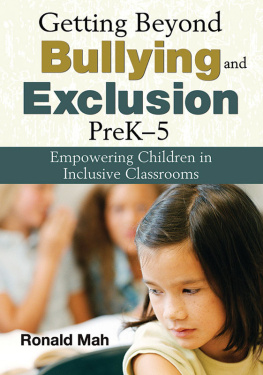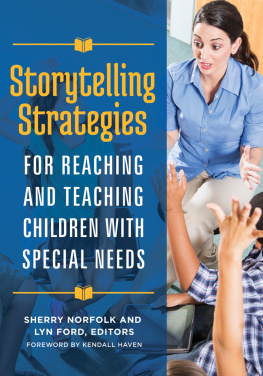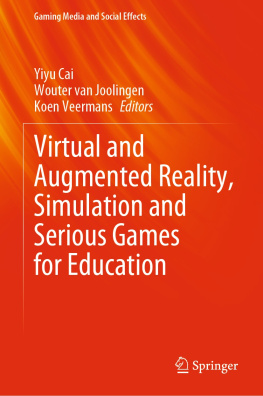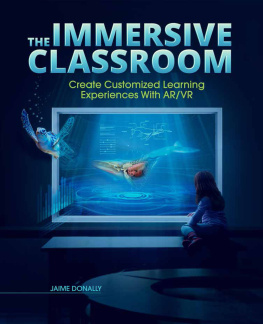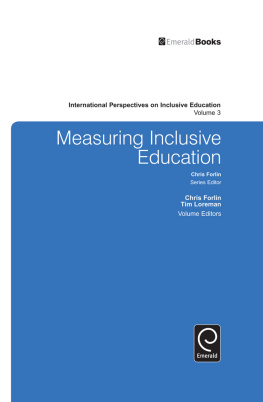Kluth - All In: 18 Ways to Create Inclusive Virtual Classrooms
Here you can read online Kluth - All In: 18 Ways to Create Inclusive Virtual Classrooms full text of the book (entire story) in english for free. Download pdf and epub, get meaning, cover and reviews about this ebook. year: 2020, genre: Home and family. Description of the work, (preface) as well as reviews are available. Best literature library LitArk.com created for fans of good reading and offers a wide selection of genres:
Romance novel
Science fiction
Adventure
Detective
Science
History
Home and family
Prose
Art
Politics
Computer
Non-fiction
Religion
Business
Children
Humor
Choose a favorite category and find really read worthwhile books. Enjoy immersion in the world of imagination, feel the emotions of the characters or learn something new for yourself, make an fascinating discovery.

- Book:All In: 18 Ways to Create Inclusive Virtual Classrooms
- Author:
- Genre:
- Year:2020
- Rating:3 / 5
- Favourites:Add to favourites
- Your mark:
- 60
- 1
- 2
- 3
- 4
- 5
All In: 18 Ways to Create Inclusive Virtual Classrooms: summary, description and annotation
We offer to read an annotation, description, summary or preface (depends on what the author of the book "All In: 18 Ways to Create Inclusive Virtual Classrooms" wrote himself). If you haven't found the necessary information about the book — write in the comments, we will try to find it.
Kluth: author's other books
Who wrote All In: 18 Ways to Create Inclusive Virtual Classrooms? Find out the surname, the name of the author of the book and a list of all author's works by series.
All In: 18 Ways to Create Inclusive Virtual Classrooms — read online for free the complete book (whole text) full work
Below is the text of the book, divided by pages. System saving the place of the last page read, allows you to conveniently read the book "All In: 18 Ways to Create Inclusive Virtual Classrooms" online for free, without having to search again every time where you left off. Put a bookmark, and you can go to the page where you finished reading at any time.
Font size:
Interval:
Bookmark:
#All In
Ways to Create
Inclusive Virtual Classrooms
#All In
Ways to Create
Inclusive Virtual Classrooms
Paula Kluth, Ph.D.
and contributors
Copyright 2020 by Dr. Paula Kluth
All rights reserved. No part of this publication may be reproduced, stored in a retrieval system, or transmitted, in any form or by any means, electronic, mechanical, photocopying, recording, or other- wise, without the prior written permission of the author.
Edited by Skye Loyd and Kendra Muntz
Cover design by David Miles
Book design by Kevin Fitzgerald
ISBN-13: 979-8-557792-24-0
Printed in the United States of America
Dedication
To all who focus on the goals of inclusion, community, and belongingno matter what.
Paula Kluth
Paula Kluth
Cori Mohr
Lisa Orvis
Lauren Arends & Paula Kluth
Robin Weckerly
Sarah Brady
Camila Dvila with Eileen Yoshina
Cecilia Sweeney & Evan Trad with Paula Kluth
Paula Kluth & Rochelle Martin
Adie Buchinsky, Samantha Toews, Jennifer Selin & Amy Hanreddy
Paula Kluth
Paula Kluth & Mary Falvey
Paula Kluth
Chanda Kulow with Paula Kluth
Paula Kluth
Jennifer Kurth, Elissa Lockman Turner & Paula Kluth
Paula Kluth
Jennifer Spencer-Iiams
Table of Contents
Introduction
A s schools closed in response to the COVID-19 outbreak in the United States, many teachers, advocates, and families became concerned that inclusion would no longer be a priority for their districts. As weeks became months, many of these same teachers, advocates, and families got creative and designed structures and strategies to help students with and without disabilities stay connected to one another and ensure that inclusive education con- tinued in virtual lessons and beyond.
The aim of this book is twofold. First, it is an attempt to catalog some of those aforemen- tioned structures and strategies. It is also a call to action: Schools must remain focused on the goal of inclusion, even when students are learning from home. Virtual learning poses many obstacles, but it also offers unique opportunities. In some ways, classrooms are more accessible in this format; students can enter and exit online classes in ways that work best for them and take different types of breaks (e.g., stand to learn, get a snack, shut off the camera) as needed. They can also respond to teacher questions and prompts in a variety of ways (e.g., verbally, by typing responses into chat boxes, by holding pictures or objects up to the webcam) and access lessons by listening, interacting with peers, or viewing related materials (e.g., teacher-created videos) asynchronously. Further, as you will see throughout this book, there is no shortage of ways students can connect to peers in our new reality.
Technology has limitations, certainly, but it also holds great potential to unite us, challenge our old paradigms, and provide access and support in ways that many of us could not have pre- viously imagined. The pandemic and the abrupt shift to virtual education has been shocking and devastating, but it has also offered insight and uncovered the need for our schools to evolve and grow. For instance, distance learning has revealed how very necessary it is to focus on belonging and community as classroom goalsin every subject area and grade level. It has inspired new conversations about teaching social and communication skills to all. It has also illuminated the need to personalize instruction and education in general.
# All In
This historical momenthowever disruptive and unwelcomeis causing a much-needed examination of what is possible in the classroom and in schools. Its allowing us to lean into inclusion and strengthen our efforts to bring all students into shared experiences and new op- portunities. When we consider the drastic differences in the look and feel of learning spaces since the spring of 2020, the expansion of tools used by educators, and the various ways we communicate and connect with one another, it is clear that all students can now be included in general education in some wayif not in every way. In virtual classrooms, architecture is not a hurdle to clear, an inability to sit and get is not an obstacle, and sensory struggles are minimized. In these circumstances, educators have unique opportunities to right some wrongs, to go all in, and to eliminate barriers to high-quality grade-level curriculum and instruction for students with and without disabilities.
So, how do we get there? How can we take advantage of these times? The structures and strategies in this book will help to answer those questions. # All In: Ways to Create Inclusive Virtual Classrooms is certainly not a thorough examination of all that is possible in distance education. Rather, it is meant to be a guide and a starting point for discussion and planning, not only for teaching in virtual spaces but for considering how to bring the learning we acquire in this format back to face-to-face classrooms. This book features stories from parents, community members, administrators, and teachers, as well as tips for making inclusion work for students of all ages. Pick one idea or try them all. Read it, share it, and pass it on.
Never waste a good crisis is a quote attributed to a few different 20th century political figures ranging from Winston Churchill to Saul Alinsky. While the origins of the phrase may be unclear, it is likely that whoever initially uttered or penned these words was not thinking about supporting students with disabilities during a global pandemic! The advice, however, seems quite fitting for this time and for this topic. Lets not squander this opportunity to expand supports, to rethink what is possible, and to see what can come from asking new questions and trying new practices in an effort to embrace the true promise of inclusive education.
Idea #1
Reach Out
Paula Kluth
W ith so many students currently learning from home, parents have become educa- tional partners in ways that would have seemed unimaginable in early 2020. Of course, moms, dads, grandparents, siblings, and other caregivers have always acted as teachers, counselors, and therapists, but distance learning requires family members to expand those roles and adopt a range of new responsibilities as well. In virtual education, parents and caregivers are our closest allies and collaborators. Therefore, regular communication with them is not just ideal, it is critical to student success.
Reaching out to families is a great way to create a positive school culture and learn more about students, but the most important reason to pick up the phone or send that note is to impact student outcomes. In a Harvard University study on collaboration, researchers found that schoolfamily communication increased the odds that students completed their homework by 40%, decreased instances in which teachers had to redirect students attention by 25%, and increased class partic- ipation rates by 15% (Kraft & Dougherty, 2013). Those kinds of results illustrate why connecting with parents and caregivers is the first strategy in this book and why it should be considered before any other strategy. Before brainstorming ideas for inclusive structures, classes, and extra- curricular activities, decide on how and when to collaborate and communicate with families. For many students with disabilities, virtual inclusion will not be sustainable without support from home, frequent teacher check-ins, and constant conversations about needs, progress, challenges,
# All In
successes, adaptations, and expectations.
There are many ways to reach out and keep your connections with family members strong. Four effective strategies are to ask and keep asking; host a coffee talk; open your office; and send a message.
Next pageFont size:
Interval:
Bookmark:
Similar books «All In: 18 Ways to Create Inclusive Virtual Classrooms»
Look at similar books to All In: 18 Ways to Create Inclusive Virtual Classrooms. We have selected literature similar in name and meaning in the hope of providing readers with more options to find new, interesting, not yet read works.
Discussion, reviews of the book All In: 18 Ways to Create Inclusive Virtual Classrooms and just readers' own opinions. Leave your comments, write what you think about the work, its meaning or the main characters. Specify what exactly you liked and what you didn't like, and why you think so.

